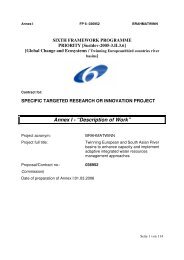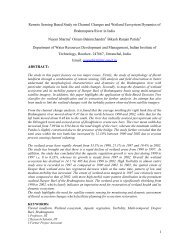WP 5 Analysis of present IWRM practices - Brahmatwinn
WP 5 Analysis of present IWRM practices - Brahmatwinn
WP 5 Analysis of present IWRM practices - Brahmatwinn
You also want an ePaper? Increase the reach of your titles
YUMPU automatically turns print PDFs into web optimized ePapers that Google loves.
3.2 Water users in the Lhasa River catchment and in the TAR in general<br />
In respect to the climate conditions the rivers in Tibet were particularly fed by the snow melt in<br />
summer month, because precipitation is very low and precipitation is moreover concentrated in the<br />
summer month during monsoon season.<br />
TAR has with 37.5% lowest proportion <strong>of</strong> urban population among regions in China, while it arrived<br />
44.94% in whole country in 2006. Anyhow, TAR has speeded up its urban planning and construction<br />
in recent decade. Official Statistics show that TAR currently has two cities at the prefecture level, 71<br />
county seats and 112 towns, with a total urban population <strong>of</strong> 420,000 and the proportion <strong>of</strong> urban<br />
population rose to 30% first time in 2000 (see Table). Using estimation method suggested by TAR<br />
Hydrology Bureau, the average per capita water demand in urban is 73 m 3 yearly and the total<br />
amount was about 73.6 million m 3 in TAR in 2006.<br />
Tab. 3: Population in TAR (100,000 persons)<br />
Year Total Urban Rural<br />
Population Population Proportion Population Proportion<br />
(%)<br />
(%)<br />
1990 218.05 35.68 16.4 187.37 83.6<br />
1991 221.79 36.26 16.4 185.53 83.7<br />
1992 225.27 37.01 16.4 188.26 83.6<br />
1993 228.88 37.84 16.5 191.04 83.5<br />
1994 231.98 38.48 16.6 193.50 83.4<br />
1995 235.55 39.83 16.7 196.17 83.3<br />
1996 239.3 40.40 16.9 198.90 83.1<br />
1997 242.74 41.72 17.2 201.02 82.8<br />
1998 245.39 43.86 17.9 201.53 82.1<br />
1999 247.72 66.87 27.0 180.85 73.0<br />
2000 251.23 79.51 31.6 171.72 68.4<br />
2001 253.7 81.30 32.0 172.40 68.0<br />
2002 255.44 83.67 32.8 171.77 67.3<br />
2003 259.21 98.43 38.0 160.78 62.0<br />
2004 263.44 100.04 38.0 163.42 62.0<br />
2005 267.55 100.78 38.0 166.77 62.0<br />
2006 268.58 100.82 37.5 167.76 62.5<br />
14<br />
The table shows that the<br />
population in Tibet<br />
increases continuously. The<br />
proportion <strong>of</strong> urban and<br />
rural population is stable<br />
since 2003. According to the<br />
trends becoming obviously<br />
in the table actually a<br />
changing <strong>of</strong> the proportion<br />
<strong>of</strong> the total population<br />
living in urban and rural<br />
areas is not expected to<br />
change significantly in the<br />
future.





